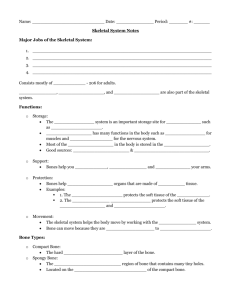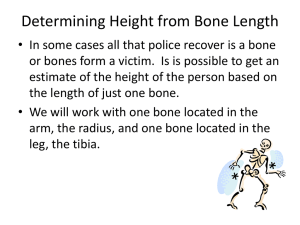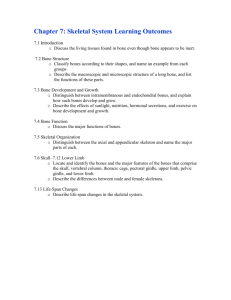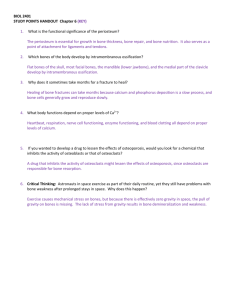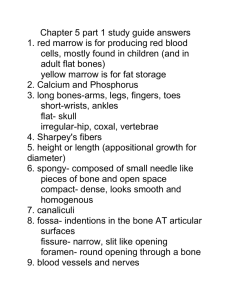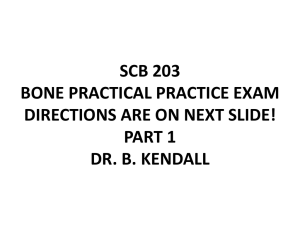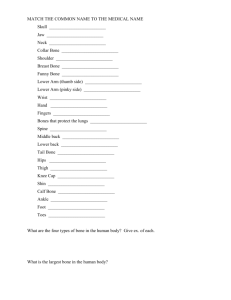Chapter 6: An Introduction to the Skeletal System Learning
advertisement
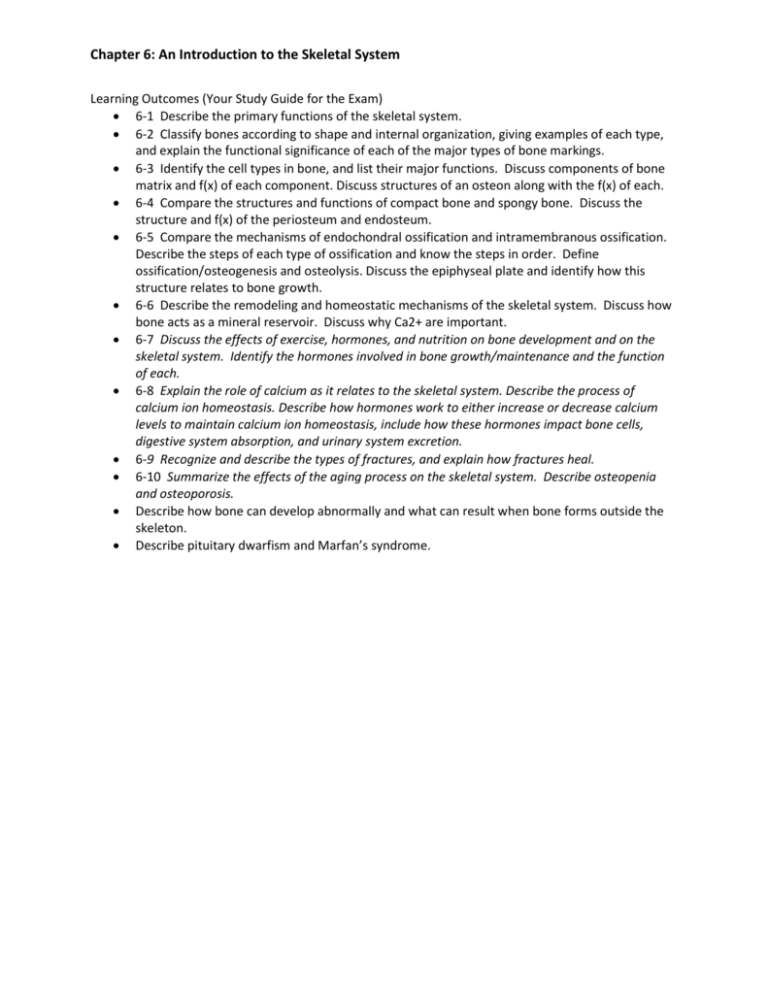
Chapter 6: An Introduction to the Skeletal System Learning Outcomes (Your Study Guide for the Exam) 6-1 Describe the primary functions of the skeletal system. 6-2 Classify bones according to shape and internal organization, giving examples of each type, and explain the functional significance of each of the major types of bone markings. 6-3 Identify the cell types in bone, and list their major functions. Discuss components of bone matrix and f(x) of each component. Discuss structures of an osteon along with the f(x) of each. 6-4 Compare the structures and functions of compact bone and spongy bone. Discuss the structure and f(x) of the periosteum and endosteum. 6-5 Compare the mechanisms of endochondral ossification and intramembranous ossification. Describe the steps of each type of ossification and know the steps in order. Define ossification/osteogenesis and osteolysis. Discuss the epiphyseal plate and identify how this structure relates to bone growth. 6-6 Describe the remodeling and homeostatic mechanisms of the skeletal system. Discuss how bone acts as a mineral reservoir. Discuss why Ca2+ are important. 6-7 Discuss the effects of exercise, hormones, and nutrition on bone development and on the skeletal system. Identify the hormones involved in bone growth/maintenance and the function of each. 6-8 Explain the role of calcium as it relates to the skeletal system. Describe the process of calcium ion homeostasis. Describe how hormones work to either increase or decrease calcium levels to maintain calcium ion homeostasis, include how these hormones impact bone cells, digestive system absorption, and urinary system excretion. 6-9 Recognize and describe the types of fractures, and explain how fractures heal. 6-10 Summarize the effects of the aging process on the skeletal system. Describe osteopenia and osteoporosis. Describe how bone can develop abnormally and what can result when bone forms outside the skeleton. Describe pituitary dwarfism and Marfan’s syndrome. Chapter 6: An Introduction to the Skeletal System I. II. III. An Introduction to the Skeletal System A. The Skeletal System Includes: 1. Bones of the skeleton 2. Cartilages, ligaments, and connective tissues 6-1 Functions of the Skeletal System A. Support: provides structure for entire body and framework for attachments of soft tissues/organs B. Storage of Minerals and Lipids 1. Bone is mineral reserve 2. Reserves of calcium salts used to maintain normal concentrations of calcium and phosphate ions in body fluids 3. Yellow bone marrow stores lipids (energy reserves) C. Blood Cell Production: occurs in red marrow D. Protection: bones shield soft tissues and organs E. Leverage: 1. bones function as levers that can change magnitude/direction of forces 2. Allows for movement 6-2 Classification of Bones by: A. ______________________ (6 bone shapes) 1. ___________________ bones: small, flat, irregular shaped bones between flat bones of skull 2. ___________________ bones: a. complex shapes with short, flat, notched or rib surface b. examples: vertebrae, bones of pelvis 3. ______________________ bones a. Small and boxy b. Examples: carpal and tarsal bones 4. ________________________ bones a. Thin, parallel surfaces b. Provide protection for underlying soft tissue c. Offer area for attachment of skeletal muscles d. Examples: roof of skull, sternum, ribs, scapulae 5. ________________________ bones a. Long and slender b. Examples: femur, humerus 6. ___________________________ bones a. Small, flat and shaped like sesame seed b. Most common near joints at knees, hands, feet c. Example: patella Chapter 6: An Introduction to the Skeletal System B. Bone markings (surface features; marks) 1. Depressions or grooves: Along bone surface 2. Elevations or projections a. Where tendons and ligaments attach b. At articulations with other bones c. Tunnels/Openings: Where blood and nerves enter bone Introduction to Bone Markings General Description Term Definition Elevations and projections Process Ramus Processes where tendons/ligaments attach Trochanter Tuberosity Tubercle Crest Line Spine Processes formed for articulation w/ adjacent bones Head Neck Condyle Trochlea Facet Depressions Fossa Sulcus Openings Foramen Canal Meatus Fissure Sinus C. Internal tissue organization/Bone Structure 1. Long Bone Structure a. ________________________: i. shaft ii. Wall contains compact (dense) bone which is relatively solid b. ________________________________: marrow cavity c. _______________________________: i. wide part at each end ii. consists mostly of spongy bone (aka cancellous or trabecular bone) iii. thin covering of compact bone = cortex d. ______________________________: where diaphysis and epiphysis meet 2. Flat Bone Structure a. Spongy Bone Sandwich b. Spongy bone (Diploe) between layers of compact bone (cortex) Chapter 6: An Introduction to the Skeletal System IV. 6-3 Bone (Osseous) Tissue A. Review of 4-4 Characteristics Connective Tissue 1. Few cells 2. Extensive extracellular matrix (ECM) a. _____________________________ composed of: i. Ground substance ii. Lacunae iii. Fibers B. Basic structure of osseous tissue 1. Matrix composed of: a. __________________________________: i. Hydroxyapatite (Calcium) ii. Function: Hard, brittle and can withstand compression b. _____________________________________: i. Collagen ii. Function: Tensile strength, tolerates twisting/bending 2. Bone cells: a. _________________________ (mature bone cells) housed in lacunae i. Cannot divide ii. Only one/lacunae iii. Develop from osteoblasts after being completely surrounded by bone matrix iv. Functions: Maintain protein and mineral content of matrix o Secrete chemicals to dissolve matrix and release minerals to circulation o Rebuild matrix Repair damaged bone b. ___________________________: Produce new bone matrix (ossification/osteogenesis) c. _________________________________: i. stem cells which divide to produce daughter cells ii. daughter cells differentiate into osteoblasts iii. important in repair of fractures d. _________________________________: i. Cells which remove/recycle bone matrix ii. Produce acids/enzymes which dissolve matrix and release stored minerals (osteolysis) iii. Important in regulating calcium and phosphate concentrations in body fluids Chapter 6: An Introduction to the Skeletal System V. C. Additional Compact Bone Structures 1. Osteon/Haversian system: basic unit of osteocytes arranged in concentric circles 2. Central/Haversian canal a. Contains blood vessels b. Carry blood to and from osteon 3. Volkmann’s/perforating canals a. Perpendicular to central canals b. Blood vessels here supply blood to osteons deeper in bone and to medullary cavity 4. ____________________________: form path for vessels/exchange nutrients and wastes between lacunae 5. __________________________: a. Concentric: circular arrangement of osteocytes in osteon b. Circumferential: wrapped around long bone binding osteons together c. Interstitial: fill spaces between osteons 6. _____________________________: a. Outer membrane covering compact bone (except in joint cavities) b. fibrous and cellular layer c. Functions: i. Isolates bone from surrounding tissues ii. Route for blood vessels/nerves iii. Bone growth/repair 7. ______________________________: a. incomplete cellular layer lining the medullary cavity b. Contains osteoblasts, osteoprogenitor cells and osteoclasts i. Functions: ii. Covers trabeculae iii. Lines central canals iv. bone growth and repair D. Structure of Spongy Bone 1. No osteons 2. __________________ = trabeculae a. Open network of fibers w/ no blood vessels b. filled with red bone marrow (forms blood cells and supplies nutrients to osteons) 3. Yellow bone marrow: stores fat The Periosteum and Endosteum 1. ____________________________: a. Outer membrane covering compact bone (except in joint cavities) b. fibrous and cellular layer c. Functions: i. Isolates bone from surrounding tissues ii. Route for blood vessels/nerves iii. Bone growth/repair Chapter 6: An Introduction to the Skeletal System 2. ___________________________ a. incomplete cellular layer lining the medullary cavity b. Contains osteoblasts, osteoprogenitor cells and osteoclasts i. Functions: ii. Covers trabeculae and lines central canals iii. bone growth and repair VI. 6-5 Bone Formation and Growth A. Human bones grow until about age 25 B. _____________________________ 1. The process of replacing other tissues with bone 2. Includes calcification: deposition of Ca salts C. Two Main forms of ossification: 1. ________________________________ a. Ossifies bones that originate as hyaline cartilage b. There are six main steps in endochondral ossification i. Chondrocytes increase in size as cartilage enlarges Matrix begins to calcify Enlarged chondrocytes die and disintegrate leaving behind cavities ii. Blood vessels grow around edges of cartilage Cells of perichondrium convert to osteoblasts Shaft of cartilage becomes covered in superficial layers of bone (perichondrium now a periosteum) Appositional growth of superficial layer increases bone diameter (occurs in periosteum) iii. Blood vessels penetrate cartilage Fibroblasts migrating in from vessels differentiate into osteoblasts Spongy bone production begins and spreads toward both ends iv. Remodeling occurs as growth continues Osseous tissue becomes thicker Osteoclasts erode trabeculae, creating medullary cavity Cartilage near epiphysis is replaced by bone Further growth increases length and diameter v. Capillaries and osteoblasts migrate into epiphyses Secondary ossification centers created vi. Epiphyses become filled with spongy bone Articular cartilage remains to prevent damaging bone-to bone contact in joint Epiphyseal cartilage separates epiphysis from diaphysis Epiphyseal cartilage disappears after puberty leaving behind epiphyseal line 2. ___________________________________________ a. occurs in the deeper layers of dermis b. Produces dermal bones such as mandible and clavicle Chapter 6: An Introduction to the Skeletal System c. There are three main steps in intramembranous ossification i. Mesenchymal cells (CT stem cells) cluster and secrete matrix Calcification of matrix occurs Mesenchymal cells differentiate into osteoblasts Ossification begins in ossification center and bone grows outward As ossification progresses, traps osteoblasts which differentiate into osteocytes ii. Blood vessels grow into area to nourish growing osseous tissue iii. Spongy bone develops initially Remodeling produces osteons of compact bone CT around bone organizes into fibrous layer of periosteum Osteoblasts closets to surface become inner cell layer of periosteum D. Blood Supply of Mature Bones 1. Nutrient Artery and Vein a. single pair of large blood vessels (exception: femur) b. Enter diaphysis through nutrient foramen 2. Metaphyseal Vessels a. Supply epiphyseal cartilage b. Where bone growth occurs 3. Periosteal Vessels: a. Blood from periosteum to superficial osteons and secondary ossification centers b. Periosteum also contains lymphatic vessels and sensory nerves VII. VIII. 6-6 Bone Remodeling A. The adult skeleton: 1. Maintains itself 2. Replaces mineral reserves 3. Recycles and renews bone matrix 4. Involves osteocytes, osteoblasts, and osteoclasts 5. Replacement/renewal usually balanced B. Bone continually remodels, recycles, and replaces 1. Turnover rate varies: 2. If deposition is greater than removal, bones get stronger 3. If removal is faster than replacement, bones get weaker 6-7 Exercise, Hormones, and Nutrition A. ______________________________ 1. Mineral recycling allows bones to adapt to stress 2. Heavily stressed bones become thicker and stronger. Why? a. Exercise stresses bones = production of electrical field = stimulation of osteoblasts B. Lack of Exercise = Bone Degeneration 1. Bone degenerates quickly 2. Up to one third of bone mass can be lost in a few weeks of inactivity Chapter 6: An Introduction to the Skeletal System C. ______________________________ 1. Diet must include calcium and phosphate salts, plus small amounts of magnesium, fluoride, iron, and manganese 2. Calcitriol a. Made in the kidneys from cholcalciferol b. Function: calcium and phosphate ion absorption from digestive tract 3. Vitamin C required for collagen synthesis and stimulation of osteoblast differentiation (deficiency = loss of bone mass/strength aka scurvy) 4. Vitamin A stimulates osteoblast activity 5. Vitamins K and B help synthesize bone proteins 12 IX. D. ______________________________ 1. Growth hormone (from pituitary gland) and thyroxine (from thyroid gland) stimulate bone growth 2. Estrogens and androgens stimulate osteoblasts 3. Calcitonin and parathyroid hormone regulate calcium and phosphate levels 6-8 __________________________________ A. The Skeleton as a Calcium Reserve: bones store calcium and other minerals 1. Calcium is the most abundant mineral in the body 2. Calcium ions are vital to: a. Membranes b. Neurons c. Muscle cells, especially heart cells B. Calcium ions in body fluids must be closely regulated 1. If calcium increases by 30% = muscle/neurons become unresponsive 2. If calcium decreases by 35% = overexcited neurons leads to convulsions 3. If calcium decreases by 50% = death C. Maintenance of Calcium ion via homeostasis 1. Ca2+ homeostasis is maintained by a. Calcitonin: decreases Ca2+ levels b. Parathyroid hormone (PTH): increases Ca2+ levels 2. Both control storage, absorption, and excretion of Ca2+ 3. When calcium levels drop: a. Parathyroid glands in neck produce PTH = i. Increases calcium ion levels by: Stimulating osteoclasts increasing intestinal absorption of calcium decreasing calcium excretion by kidneys ii. Result: increase in calcium levels = homeostasis restored 4. When calcium levels increase: a. Calcitonin secreted by thyroid = i. Decreases calcium ion levels by: Inhibiting osteoclast activity Increase calcium excretion at kidneys ii. Result: decrease in calcium levels = homeostasis restored Chapter 6: An Introduction to the Skeletal System VII. VIII. 6-9 ______________________________ A. Crack/break in bone B. Caused by physical stress C. Repaired in four steps 1. Fracture breaks vessels causing bleeding a. Fracture hematoma (blood clot) closes off injured vessels b. Disruption of circulation kills osteocytes 2. Periosteum and Endosteum activated a. Cells undergo rapid mitosis b. Daughter cells migrate to fracture a. External callus and internal callus form b. Cells of callus differentiate into osteoblasts to establish bridge between broken bone fragments and stabilize area 3. Osteoblasts replace cartilage in external callus with spongy bone a. Dead bone fragments have been removed and replaced b. Cast can now be removed 4. Osteoclasts and osteoblasts continue to remodel fracture D. Types of Fractures 1. Broadest classification simple vs. compound a. Simple: only seen on x-ray, closed fracture b. Compound: project through skin c. Other types of fractures Type of Fracture Description Transverse Shaft broken across long axis Displaced Produce new and abnormal bone arrangements Compression Occur in vertebrae subjected to extreme stresses (e.g. forces that arise when you land on your buttocks in a fall) Spiral Produced by twisting stresses that spread along length of bone Epiphyseal Occur where matrix is undergoing calcification Comminuted Shatter affected area into bony fragments Greenstick Only one side of shaft is broken, other is bent (generally in children only) Colles Break in distal portion of radius (may happen when reach out to cushion fall) Pott’s Occurs at ankle and affects both bones of leg 6-10 Effects of Aging on the Skeletal System A. Bones become thinner and weaker with age 1. Osteopenia begins between 30 - 40 a. Inadequate ossification/osteoblast activity declines = loss of bone mass b. Women lose 8% of bone mass/decade, men 3% c. The epiphyses, vertebrae, jaws most affected d. Result = fragile limbs, reduction in height, tooth loss 2. Osteoporosis begins over age 45 a. Severe bone loss b. Affects normal function c. Increases possibility of fracture d. Occurs in 29% women and 18% men Chapter 6: An Introduction to the Skeletal System IX. e. Why more women than men? a. Sex hormones important in bone deposition b. Menopause = drop in estrogens = drop in bone deposition c. In males, androgens are produced until late in life Abnormal Development of Bone A. FOP (Fibrodysplasia Ossificans Progressiva) 1. Genetic disease causing formation of bone in wrong place after minor injury 2. Muscles of back, neck, upper limbs gradually replaced by bone B. Pituitary dwarfism 1. Inadequate production of growth hormone = reduction in epiphyseal cartilage activity = abnormally short bones 2. Rare in US due to treatment with synthetic growth hormone C. Marfan’s syndrome 1. Characterized by long, slender limbs, individuals very tall 2. Due to excessive cartilage formation at epiphyseal cartilages

